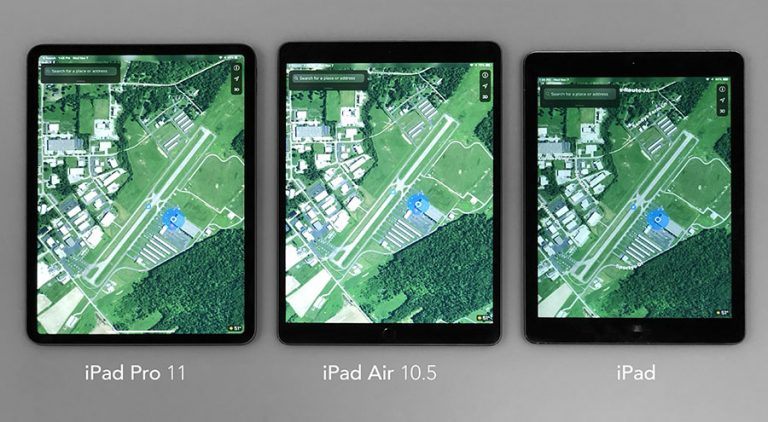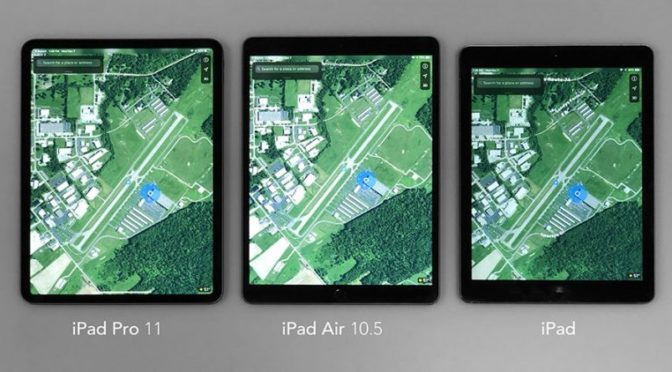
The original Apple iPad was released nine years ago on April 3, 2010. Since then Apple has continuously improved the tablet, making upgrades to its storage capacity, screen resolution, processor, connectivity options and form factor. The iPad Pro 11″ and 12.9″ are the top end models currently available for sale today, and represent an enormous leap in performance over the original iPad, like going from a Cub to a Learjet.
While these high-performance pro models would suit (and honestly exceed) most pilots’ needs in the cockpit, there are some other options and features worth considering when purchasing an iPad for use in aviation. Here we’ll break down the differences in each, and give some insight for those looking to buy a used or refurbished iPad, which is a great way to save some money.
iPad Pro, iPad or iPad Mini?

Apple currently offers 5 models of iPad: the iPad Mini 5, the iPad, the iPad Air 10.5″, the iPad Pro 11″ and the iPad Pro 12.9″. The iPad, iPad Air 10.5″ and the iPad Pro 11″ feature nearly the same external dimensions and pilots will find that all three work very well with nearly every aviation app available. The 10.5” and 11” specs on the mid-size models refer to the screen’s diagonal dimension, meaning these models feature more screen real estate than the standard iPad, while maintaining a similar form factor. The entry-level iPad’s screen measures 9.7″ diagonal.
The iPad Pro 11″ improves on the discontinued iPad Pro 10.5″ design by including a large edge-to-edge display, high-performance processor, and FaceID to quickly unlock the device (read our PIREP on this model here). It also includes a bright, high-resolution liquid retina display with an anti-reflective coating. The latest iPad Pro 12.9″ model represents a major improvement over the original iPad Pro 12.9″ – it is 25% smaller while retaining the same display size, thanks to the edge-to-edge screen. The footprint is about the same as a sheet of paper, so it’s a good fit now in most GA cockpits. It comes at a premium price, but we can recommend this model now for those who want the most screen real estate possible.
The budget-friendly model referred to now as just “iPad” is no slouch and features Apple’s powerful A10 Fusion Processor. This is a great buy for less than half the price of the Pro model, but there’s no doubt the iPad Mini, Air and Pro models will offer significantly better performance when flying with graphic-intensive aviation apps.
If you’re looking for an iPad with a smaller footprint, consider the iPad mini. This version measures 7.87″ by 5.3″ and will be a better fit in cockpits with tighter constraints. It runs at the exact same resolution as the full-size iPad model, so all the iPad apps currently available are compatible with it. It was updated in 2019 with the latest high-performance A12 processor, which puts its performance nearly on par with the iPad Pro. It also includes the anti-reflective screen coating which pilots will find useful in the cockpit (read our PIREP on this model here). For a sense of the size, here’s a picture of an iPad Mini 5 in a Cessna 172 cockpit.
If you’re using an iPad 3, 4, Air 1, Air 2, or Mini 4, it may be time to consider an upgrade. While most apps will still run on these models, the processor is noticeably slower. You may find map redraws and other higher-end features to be frustrating. Plus, the latest version of Apple’s iOS platform won’t run on the original iPad 1 – 3, so you’ll be stuck on an older version.
WiFi-only or WiFi + Cellular model?
After choosing a size, it’s on to the connectivity question. This is pretty simple, but there are some confusing terms thrown around, so let’s start basic.

Every iPad model ever built offers WiFi connectivity to the internet, so you can connect to your home network, your office network, a local coffee shop, etc. But you can also buy an upgraded cellular model – called LTE – that receives wireless data from AT&T or Verizon (for a monthly fee). The benefit to pilots with the cellular model is that it also contains an internal GPS receiver, which is useful for showing your aircraft’s position on aviation map applications (although it has some minor limitations). The cellular model also allows you to download weather and file flight plans on the go, but don’t count on this cellular data connection to work in the air. In our experience, it just isn’t reliable. It’s also technically illegal.
The internal GPS on an iPad with cellular data is completely independent of the cellular antenna and does not require that you activate a data plan from AT&T or Verizon to work properly. You could buy a cellular model iPad and use the GPS without ever activating your service.
So which is the right choice for pilots? Either one, really. The GPS that comes with the LTE model is nice, but for the price of this upgrade, you could buy an external iPad GPS that is more reliable in some ways. We’d advise you choose the cellular model iPad only if you think you’ll use that mobile data connection a lot.
Storage capacity
Apple offers multiple versions of internal memory options for iPads: the entry-level iPad is available in two sizes, either 32GB or 128GB, while the newer Mini and Air models feature are available in 64GB and 256GB sizes. The Pro models go even bigger, with the option to upgrade to 512GB and 1 TB storage options. Downloading all the VFR & IFR charts for the entire United States across multiple data cycles can take nearly 20GB, so even the smallest option available can work. And then you have to consider that you might also want to store high-resolution terrain data, synthetic vision, charts for the Canada, Mexico and Caribbean, and PDF documents.

Another thing to keep in mind is that many apps like ForeFlight allow you to download the next cycle’s charts approximately 4 days in advance. If you plan to keep charts for the entire U.S. on your iPad, you’ll need additional free space during this transition period each month.
Finally, consider that you may use the iPad for more than just aviation (e.g., pictures, videos, other apps), so you’ll want to leave open some free space for those items. The iPad’s memory is not upgradeable, so you have to commit to a size up front. If in doubt, go with the 256GB option; 64GB may sound like a lot now, but it doesn’t leave much room for future growth as new aviation databases and features are introduced and your photo and music libraries continue to expand.
Conclusion
The good news is that any iPad model will work for pilots, so there’s not a bad choice here. But some are definitely better than others. So which model do we recommend? Based on our experiences flying with each model of iPad, we think the 11″ iPad Pro, WiFi-only, 256GB is the ideal choice if you’re looking to buy a new iPad or upgrade from an older model. For those on a budget, the 10.5″ iPad Air WiFi-only, 256GB is a great alternative, available for nearly half the price of the Pro model. And for those that prefer the smaller footprint of the iPad Mini, the iPad Mini 5 was updated in 2019 with a high-performance processor and is highly recommended.
For the ultimate big-screen experience on the flight deck, we can now recommend the new 12.9″ iPad Pro thanks to its 25% smaller size. It’s not cheap, but for those who like the big display and had previously tried to shoehorn the original 12.9″ model in the cockpit, the new one is worth a second look.
We’ve found the reliability and performance of external GPS receivers to be far superior to the internal option, and they’re available for under $100 – less than the upgrade to the cellular model. For the ultimate setup, we recommend adding a wireless ADS-B receiver, like Stratus ADS-B receiver, which provides subscription-free in-flight weather and WAAS GPS position data.
Lastly, keep an eye on Apple’s refurbished iPad offerings. They will look brand new to you out of the box, and include a new internal battery and the same warranty as a new iPad. It’s a great way to save $100 or more on a higher-end model.
To compare the iPad models, or to purchase, visit Apple’s website. To see how different sizes look in the cockpit of a Cessna 172, read this article.
The post What’s the best iPad for pilots – 2019 edition appeared first on iPad Pilot News.
Source: Ipad appsWhat’s the best iPad for pilots – 2019 edition


